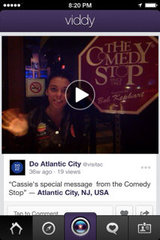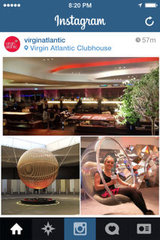Short video: a rising, shining star on the travel industry horizon
Andrew Hennigan has been investigating the uses of short video sharing and finds that it's not just about YouTube.
When Twitter was launched in 2006 most experts could not see why anyone would want to send updates of just 140 characters. How wrong they were.
Six years later, in October 2012, Twitter acquired a startup called Vine, which allows users to share six-second looping video clips. Although people were more cautious in waiting to see what would happen, Vine became the most downloaded app early in 2013.
IMAGE VINE APP
So while Google’s YouTube may be the undisputed king of video sharing, today the availability of apps designed to share very short video clips are adding the visual equivalent of Twitter to the social media toolbox. Twitter’s Vine, Facebook’s Instagram and a wave of startups like Viddy, Mobli and Keek all offer variations on the same short video theme. Early adopters in travel businesses are already exploiting this new opportunity and teaching others’ valuable lessons.

Early adopters
One of the earliest adopters of Vine in the travel industry, or indeed anywhere, was Iceland Travel, a travel agent, tour operator and destination management company in Iceland. “We started using Vine ten days after it was released,” says Hrafnhildur ‘Habba’ Svansdóttir, project manager in Iceland Travel’s social media marketing team. “Vine videos are an excellent way for us to show consumers some of the exciting places they can visit.”
Iceland Travel has already posted nearly 200 Vines, typically showing Icelandic landscapes (sample Vine from Jökulsarlon) from the ground and from the air. With the natural background sound they give a compelling sense of the natural beauty of the country. “We believe that this is a great chance for businesses to show the real essence of a product and a way for consumers to get a sense of the destination they would like to visit,” says Svansdottir.

VisitScotland has also adopted the new medium enthusiastically, using Vine to share clips of destinations and activities (sample Vine of Strathspey). “We have a tight focus on core channels,” says Calum Shepherd, Search & Social Media Manager at VisitScotland, “and we are constantly looking at opportunities to grow these organically.” According to Shepherd, Vine is a “fantastic channel” that complements existing activity on Twitter, but has one of the most creative communities for content creation.
Vine’s limitations drive this creativity because a conventional YouTube video style does not work well with a six-seven second time limit. You can see this creativity at work in VisitScotland’s Vine campaign promoting Scottish castles as a Halloween destination. These seasonal Vines use stop motion animation and eerie sound effects to create a ghostly ambience and demonstrate just how much you can achieve in a few seconds (sample Halloween Vine). “The Halloween castle Vines were created in-house using stop motion animation and using only the Vine app itself,” explains Shepherd.

Across the pond
In the US the Atlantic City Alliance takes a different approach to content. It aligns its videos with its target market: fun seekers. “Our strategy for Vine is to create and capture ‘of the moment’ Atlantic City experiences,” says social media manager Eric Cortes. “These include shooting our custom built, pop-up destination resort #LivefromAC where we capture winning moments (sample competition Vine), prizes and contests.”

Initially the Vine app was limited to essential functions but once the success of the platform became clear competitors soon entered the market, offering additional functions. Vine has since been updated to introduce similar features. In the latest update users can shoot short pieces of video in any order, trim each clip and even change the order of clips before uploading the finished video or sharing it through other platforms.
Rival Instagram, originally a photo-sharing service, added short video sharing in June 2013. Compared to Vine, Instagram offered clips of up to 15 seconds in their trademark square format, plus ‘filters’ that change the appearance of videos just like Instagram photos. Meanwhile an independent startup called Viddy offers a more movie-like experience, with 16:9 format, up to 30 seconds duration, Instagram-like filters and the possibility of adding background music. Feature comparisons tend to be of little value, however, as each upgrade usually adds the best features from competitors.
Getting there first
Most travel businesses have chosen Vine initially, simply because it was there first. Some like Iceland Travel, VisitScotland and The Gathering Ireland already use the service regularly and many others have created placeholder Vine accounts for brand protection. Other users like Visit New Orleans and VirginAtlantic have chosen Instagram, merging their photo and short videos into a single stream.

Increasingly, though, companies are using more than one short video channel. The Gathering Ireland 2013 (see Global gatherings covering multiple platforms from the fair green isle, EyeforTravel, April 4, 2013) uses a combination of Vine and Instagram Video. “Vine is ideal for adding to the conversation on Twitter as clips loaded in stream,” says Amanda Kavanagh, community manager for the project. “During the People’s Parade at St Patrick’s Festival we were live tweeting from the middle of it using Vine and also boosted it with a promoted tweet.” (Sample The Gathering Vines.)
But sometimes Instagram Video works better. “For the FlightFest we tried some clips on Vine but got better engagement with Instagram clips. If the conversation is on Twitter we’ll use Vine as Twitter favours it. If the conversation is happening on Facebook we’ll be more likely to use Instagram, though I think Facebook could do some work to help integrate Instagram sharing on Facebook. Instagram content doesn’t really stand out on Facebook as it is.” (The Gathering Instagram Videos).

Early adopters, like Iceland Travel, VisitScotland, Atlantic City Alliance and others, have demonstrated that short video can be a surprisingly effective tool, especially when combined with other social channels. In fact in 2014 it is likely that this will be a mainstream channel of communication for the travel industry. Meantime the early adopters are already exploring newer technologies, like ‘spherical’ panoramic photos, that allow consumers to view a landscape or interior in any direction. But that is another story and one that we will be covering soon on EyeforTravel.com.

